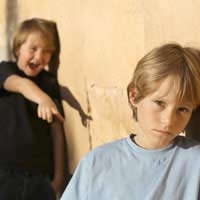New Zealand Australia School Bullying
TIMSS 2007 International Mathematics Report: Findings from IEA’s Trends in International Mathematics and Science Study at the Fourth and Eighth Grades
Mullis, I.V.S., Martin, M.O., & Foy, P. (with Olson, J.F., Preuschoff, C., Erberber, E., Arora, A., & Galia, J.). (2008). Chestnut Hill, MA: TIMSS & PIRLS International Study Center, Boston College.

New Zealand has been ranked second worst among 37 countries when it comes bullying in primary schools, according to a major international report.
Almost three quarters of about 5000 New Zealand year five students said they had been bullied in the past month in the Trends In International Mathematics And Science Study (TIMSS).
The same study, which was released last week, also found that local pupils were lagging behind Kazakhstan when it came to science prowess, scoring just above the international average. In maths they scored below the international average.
When it came to bullying only Tunisia ranked lower – with 77 per cent of students reporting bullying in the last month.
Bullying was defined as having something stolen, being hit or hurt by another student, was left out, made fun of, or made to do something you didn't want to do.
New Zealand also ranked second worse when it came to students experiencing three of more of those forms of bullying in the past month, with 33 per cent reporting such experiences.
Only Taiwan, with 35 per cent, was worse.

New Zealand's rates were more than 50 per cent above the international average.
Australia also fared badly in the year five section of the study – just above Qatar, Taiwan, New Zealand and Tunisia – with 70 per cent of students reporting some form of bullying in the past month and 26 per cent saying they had experienced three or more kinds.
Labour's education spokesman, Chris Carter, said parents "would be horrified" by the report's findings
"This shocking news must be a wake up call for the new National-ACT Government to focus education resources on making our schools safer for students."
Mr Carter, Labour's former education minister, defended his own record, saying he had instructed the Education Review Office to ensure schools had strategies in place to combat bullying.
Resource cards had also been distributed to students on the subject.
A spokeswoman for Education Minister Anne Tolley said she had not been briefed on the figures, but would look into it "as a priority".

She said she saw bullying in schools as a serious issue that needed to be addressed and Labour's efforts in the area had been lacklustre.
Its resource cards were a gimmick that were either likely to be lying languishing in classrooms or to have been tossed into the rubbish by students.
Mr Carter said 220 New Zealand primary schools had taken part in the study, the major part of which was released last week.
More than 600 New Zealand principals and teachers were surveyed as well as 4940 Year five students.
-NZPA
==========
Bullying in Australian primary schools is in the worst category in the world, according to a new study tracking global education standards.
More than a quarter of Australian year 4 students said they had suffered bullying in the Trends In International Mathematics And Science Study which surveyed schools in about 40 countries.
The results have alarmed child health experts and education bodies which have been running strict anti-bullying programs in schools over the past six years.
Australian primary school students suffer bullying at a rate of almost 50 per cent above the international average, putting Australia in the worst category for bullying.
Of the 36 countries sampled in the survey of year 4 students, only Kuwait, Qatar, Taiwan and New Zealand fared worse than Australia.
The Trends In International Mathematics And Science Study which found Australia dragging behind its neighbours and even Kazakhstan in maths and science education found more than a quarter of Australian year 4 students had been bullied in at least three ways in the month before they were tested.
The study, produced by the International Association for the Evaluation of Educational Achievement, asked if they had experienced any of five antisocial behaviours in the previous month whether something of theirs had been stolen, they had been hurt by other students, they had been made do things against their will, they had been teased or they had been excluded by others.
In Australia, where almost 460 schools participated in the study, 26 per cent of year-four students had encountered at least three of the behaviours in the period.
Internationally, 42 per cent of primary school students said they had experienced none of the behaviours.
In Australia, it was less than 33 per cent.
Queensland Primary Principals Association (APPA) spokesman Tony McGruther said he was alarmed by the suggestion bullying was worse in Australian than overseas.
''I have visited schools in the United States and Canada and Australian schools would not appear any more conducive to incidents of bullying than schools in those countries,'' Mr McGruther said.
He suggested the figures did not reflect a worsening pattern of bullying in Australian schools but rather highlighted students' increased awareness of antisocial behaviour.
''I don't believe this is a reflection of an increased number of bullying incidents in Australian schools,'' Mr McGruther said.
''Australian children have been made far more aware of the issue through strong anti-bullying campaigns in schools and are therefore more likely to identify incidents of bullying and then report on those incidents in a survey,'' Mr McGruther said.
However, Queensland Education Minister Rod Welford said the figures concerned him.
He suggested they reflected the country's growing culture of aggression.

''This is alarming,'' Mr Welford said.
''In the broader community there is perhaps a weakening of standards of behaviour.
''We have to increase student's social and emotional resilience, responsibility and respect.
''Those schools that have a high standard of behaviour work more closely with parents...good behaviour must be reinforced at school and at home.''
Mr McGruther said the shocking figures were possibly a reflection of a sharp increase in the number of children with mental health issues.
As many as one in seven Australian children suffer from anxiety, he said.
"Children suffering anxiety or another mental illnesses are far more likely to act out at school."
Former Queensland Catholic Primary Principals Association President Terrence Grant said anti-bullying policies in schools were working.
He agreed the survey results were evidence of the success of anti-bullying programs.
''Children are more likey now to discuss incidents of bullying at school with their parents at home,'' Mr Grant said.
''We get great cooperation from families to help us solve problems of bullying that arise in schools.''
Mr Grant, who is also the principal of Saint Gerard Majella Catholic Primary School in Woree, in north Queensland, said there had been no significant change in the prevalance of bullying in Australia.
''Bullying occurs now the same as it did years ago,'' he said.
However Stacey Waters, a research fellow at the Child Health Promotion Research Centre at Edith Cowan University, said the type of bullying that had changed, but that had not affected numbers.
''Eighty-three per cent of kids who are face-to-face bullied are also cyber bullied. It's not like there's a new group of kids that are being bullied; it's just increasing the dose.
They're just being bullied in more ways now,'' Mrs Waters said.
''It was historically fairly aggressive face-to-face bullying. It's now more covert.''===============
Of the 36 countries sampled in the survey of year four students, only Kuwait , Qatar, Taiwan and New Zealand fared worse than Australia.
14 December 2008 - 5:11pm — NZPA
By Grant Fleming of NZPA
Wellington, Dec 14 NZPA - New Zealand has been ranked second worst among 37 countries when it comes bullying in primary schools, according to a major international report.
Almost three quarters of about 5000 New Zealand year five students said they had been bullied in the past month in the Trends In International Mathematics And Science Study (TIMSS).
The same study, which was released last week, also found that local pupils were lagging behind Kazakhstan when it came to science prowess, scoring just above the international average. In maths they scored below the international average.
When it came to bullying only Tunisia ranked lower -- with 77 percent of students reporting bullying in the last month.
Bullying was defined as having something stolen, being hit or hurt by another student, was left out, made fun of, or made to do something you didn't want to do.
New Zealand also ranked second worse when it came to students experiencing three of more of those forms of bullying in the past month, with 33 percent reporting such experiences.
Only Taiwan, with 35 percent, was worse.
New Zealand's rates were more than 50 percent above the international average.
Australia also fared badly in the year five section of the study -- just above Qatar, Taiwan, New Zealand and Tunisia -- with 70 percent of students reporting some form of bullying in the past month and 26 percent saying they had experienced three or more kinds.
Labour's education spokesman, Chris Carter, said parents "would be horrified" by the report's findings
"This shocking news must be a wake up call for the new National-ACT Government to focus education resources on making our schools safer for students."
Mr Carter, Labour's former education minister, defended his own record, saying he had instructed the Education Review Office to ensure schools had strategies in place to combat bullying.
Resource cards had also been distributed to students on the subject.
A spokeswoman for Education Minister Anne Tolley said she had not been briefed on the figures, but would look into it "as a priority". She said she saw bullying in schools as a serious issue that needed to be addressed and Labour's efforts in the area had been lacklustre.
Its resource cards were a gimmick that were either likely to be lying languishing in classrooms or to have been tossed into the rubbish by students.
Mr Carter said 220 New Zealand primary schools had taken part in the study, the major part of which was released last week.
More than 600 New Zealand principals and teachers were surveyed as well as 4940 Year five students.
NZPA PAR gf mgr
 Stumble It!
Stumble It!
0 Comments:
Post a Comment
<< Home